Investment Risks and Strategies Amid Geopolitical Tensions
Greencore PLC: A Financial Report
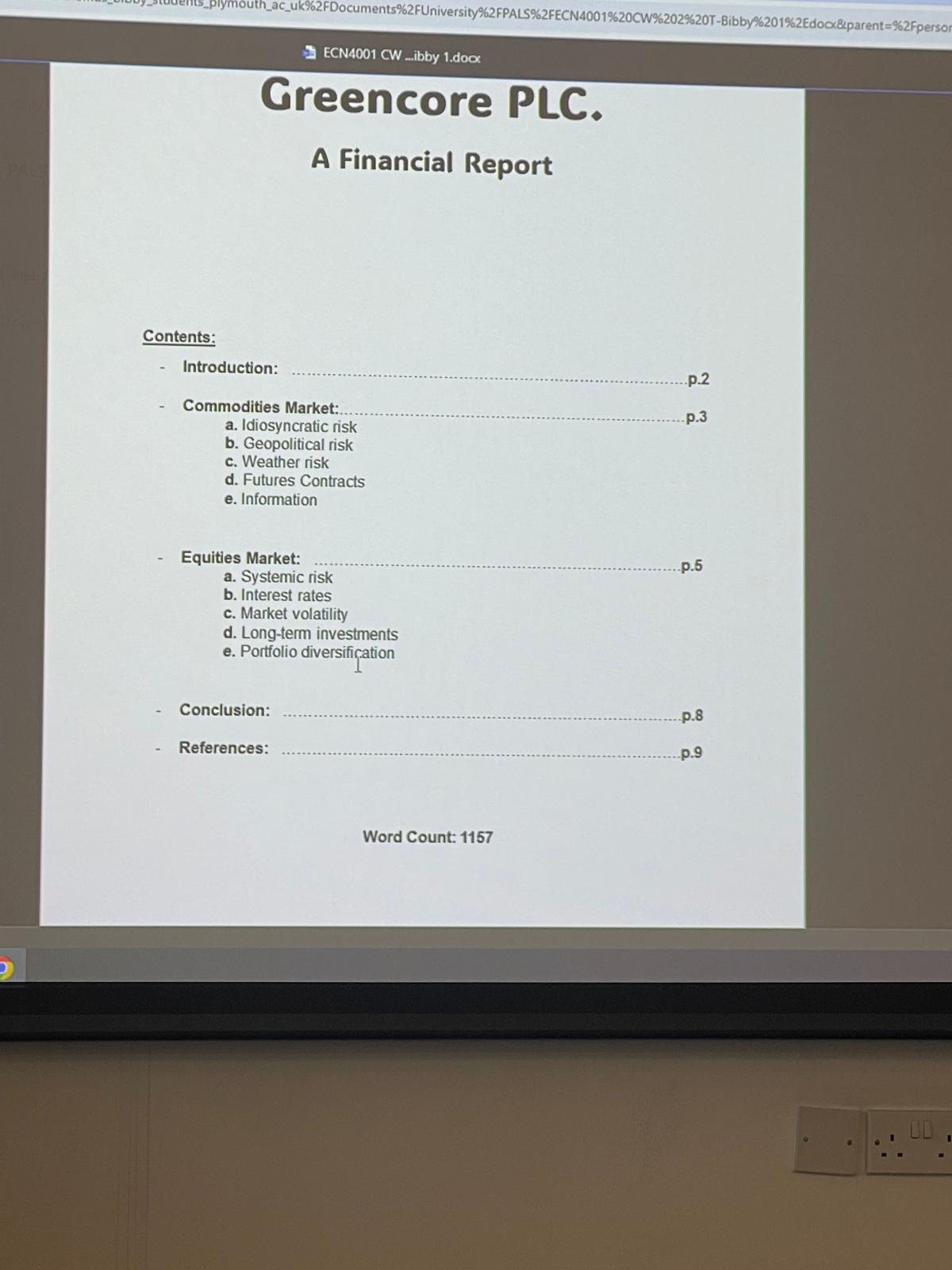
Contents
Introduction
- Overview of the financial report for Greencore PLC.
Commodities Market
-
Idiosyncratic Risk (p.3)
- Definition: Risk specific to a single asset or company, uncorrelated with the overall market.
- Insight: Diversification can mitigate this type of risk.
-
Geopolitical Risk
- Definition: Risk arising from political events in a specific country or region that can affect market stability.
- Insight: Often impacts commodities heavily reliant on specific locations for production or supply.
-
Weather Risk
- Definition: The impact of unexpected weather changes on financial markets, particularly in agriculture and energy.
- Insight: Weather derivatives can be used to hedge against these risks.
-
Futures Contracts
- Definition: Agreements to buy or sell an asset at a future date at an agreed-upon price.
- Insight: Used by businesses to lock in prices and hedge against price volatility.
-
Information
- Insight: Access to timely and accurate information is crucial for making informed trading decisions in the commodities market.
Equities Market
-
Systemic Risk (p.5)
- Definition: Risk inherent to the entire market or a market segment.
- Insight: Cannot be mitigated through diversification, but strategies like asset allocation can help.
-
Interest Rates
- Insight: Changes in interest rates can have significant impacts on equity markets, affecting investment costs and returns.
-
Market Volatility
- Definition: Refers to the degree of variation in trading prices over a certain period.
- Insight: High volatility often increases investor risk but also opportunities for returns.
-
Long-term Investments
- Insight: Typically involve holding assets for more extended periods, focusing on future growth potential.
-
Portfolio Diversification
- Definition: Strategy to reduce risk by investing in a variety of assets.
- Insight: A diversified portfolio reduces the impact of individual asset volatility.
Conclusion
- A wrap-up of the findings and analysis discussed in the report, summarizing key risks and strategies.
References (p.9)
- Citing sources and data used in the preparation of the financial report.
Word Count: 1157
- The total number of words in the financial report providing an estimate of the document's length.
Extended readings:
Risk Management for Equities Markets
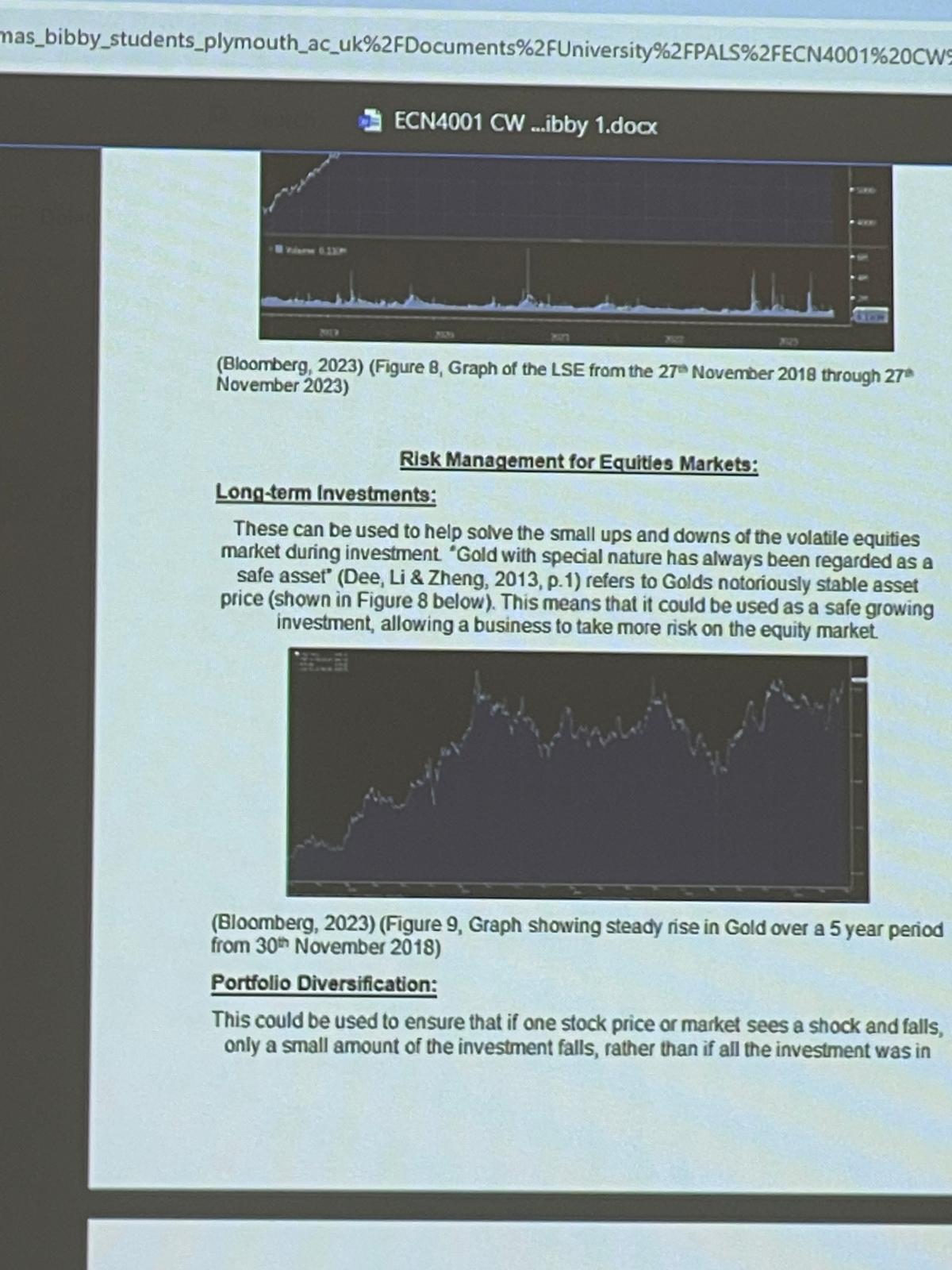
Long-term Investments
-
Stability in Volatile Markets:
- Long-term investments can help manage the volatility of equity markets. By focusing on long-term assets, investors can buffer against short-term market fluctuations.
- Gold as a Safe Asset:
- Gold is traditionally seen as a stable, safe-haven investment. It is often used to hedge against inflation and currency fluctuations because of its historical resilience in preserving value.
- Insight: Investors often diversify their holdings into gold during economic downturns or periods of uncertainty to preserve capital.
-
Graph Analysis:
- The graph from Bloomberg (2023) shows the London Stock Exchange (LSE) performance from November 27, 2018, to November 27, 2023. The chart likely shows trends and fluctuations over the five-year period, highlighting the importance of staying invested over a longer timeframe.
Portfolio Diversification
-
Risk Mitigation Strategy:
- Diversification involves spreading investments across various financial instruments, industries, and other categories to minimize risk.
- By diversifying, an investor can reduce the impact of a single asset or sector's poor performance on the overall portfolio.
- Insight: An effective diversification involves a mix of asset classes like stocks, bonds, and commodities to balance potential returns and risks.
-
Graph Analysis:
- The Bloomberg (2023) graph illustrates a steady rise in gold prices over the five-year period from November 30, 2018. This reinforces gold's reputation as a reliable long-term investment vehicle amidst fluctuating equity markets.
Additional Insights
- Economic Context:
- During times of economic uncertainty, such as recessions or geopolitical tensions, investors tend to gravitate towards assets like gold, which are perceived as more stable.
- Strategic Asset Allocation:
- A thoughtful allocation strategy that incorporates long-term investments and diversification can enhance portfolio resilience and potential returns over time.
These notes provide a comprehensive understanding of risk management strategies, particularly focusing on the stabilizing role of gold and the benefits of diversification in equity markets.
Extended readings:
Investment Risks and Strategies
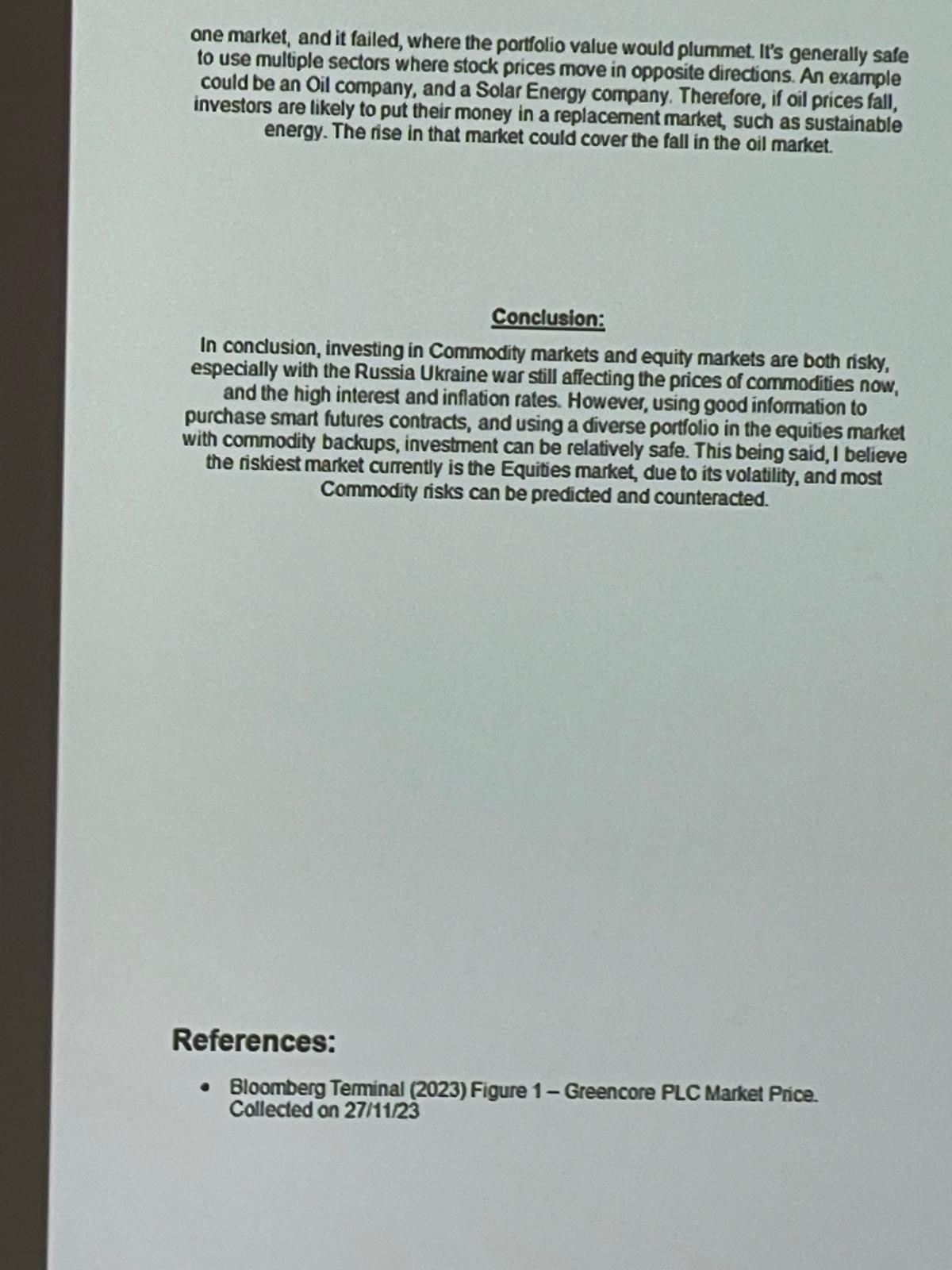
Conclusion
-
Investment Risks:
-
Investing in commodity and equity markets is considered risky.
-
The ongoing Russia-Ukraine conflict affects commodity prices.
-
High interest and inflation rates add to the uncertainty.
Insight: Geopolitical events like wars can cause significant fluctuations in commodity prices, impacting global markets due to supply chain disruptions and resource availability.
-
-
Investment Strategy:
-
Use informed futures contracts.
-
Diversify portfolios with commodities as backup.
-
Despite risks, equities can be safer with diversification.
Insight: Diversification is crucial in mitigating risks. By spreading investments across different sectors, one can balance out potential losses.
-
-
Market Risk Comparison:
-
Equities market is currently the riskiest due to its volatility.
-
Commodity risks can be predicted and countered.
Insight: The equities market can experience rapid changes in value, offering both high risk and potentially high rewards. Understanding market trends and indicators is essential.
-
References
- Source:
-
Bloomberg Terminal (2023)
-
Data: Greencore PLC Market Price, collected on 27/11/23
Insight: Bloomberg Terminal is a comprehensive tool for accessing current market data. It’s crucial for tracking investment performance and making informed decisions.
-
Extended readings:
Stock Market Insights and Analysis
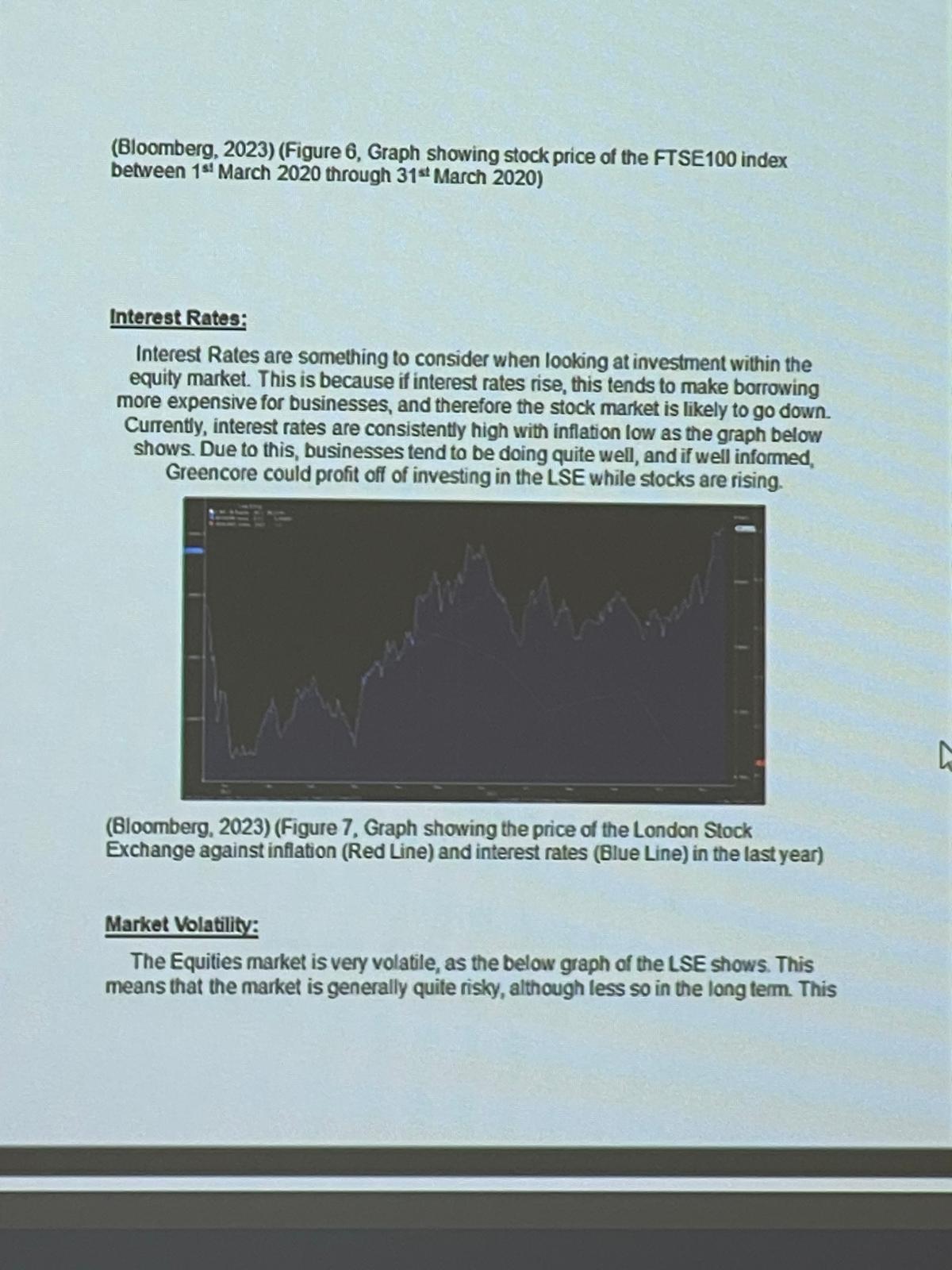
Interest Rates
-
Understanding Interest Rates:
Interest rates play a crucial role in investment decisions within the equity market. When interest rates increase, borrowing becomes more expensive for businesses, often leading to a downturn in the stock market. -
Current Scenario:
The image explains that the current interest rates remain consistently high with low inflation. This environment typically benefits businesses, as shown in the graph mentioned from Bloomberg, 2023. Companies like Greencore could potentially capitalize on this by investing in rising stocks within the London Stock Exchange (LSE). -
Investment Implications:
When inflation is low, the purchasing power of money remains stable, encouraging consumption and business profits. Therefore, understanding the interplay between interest rates and inflation can help investors make informed decisions about market participation.
Market Volatility
-
Equities Market Volatility:
The equities market is described as highly volatile, implying significant risks for investors. According to the chart in the analysis, short-term market movements are unpredictable, but risk levels decrease over the long term. -
Risk Management:
Volatility indicates price fluctuations over a certain period and can be both a risk and an opportunity. For long-term investors, riding out short-term market swings is often a strategic decision that can lead to substantial future gains.
Additional Information
-
Reading Graphs:
Understanding graphs, like Figure 6 and Figure 7, is essential for interpreting market conditions. Figure 6 refers to the FTSE100 index, a benchmark for the UK stock market, while Figure 7 illustrates the interplay between the LSE prices, inflation, and interest rates over the past year. -
Market Analysis Tools:
Investors often use historical data, trends, and economic indicators to forecast market conditions. Combining quantitative data like interest rates with qualitative assessments (e.g., market news, political developments) enhances the decision-making process.
By mastering these insights, investors can effectively navigate and leverage market dynamics to optimize their investment strategies.
Extended readings:
Commodity Market Risks and Insights
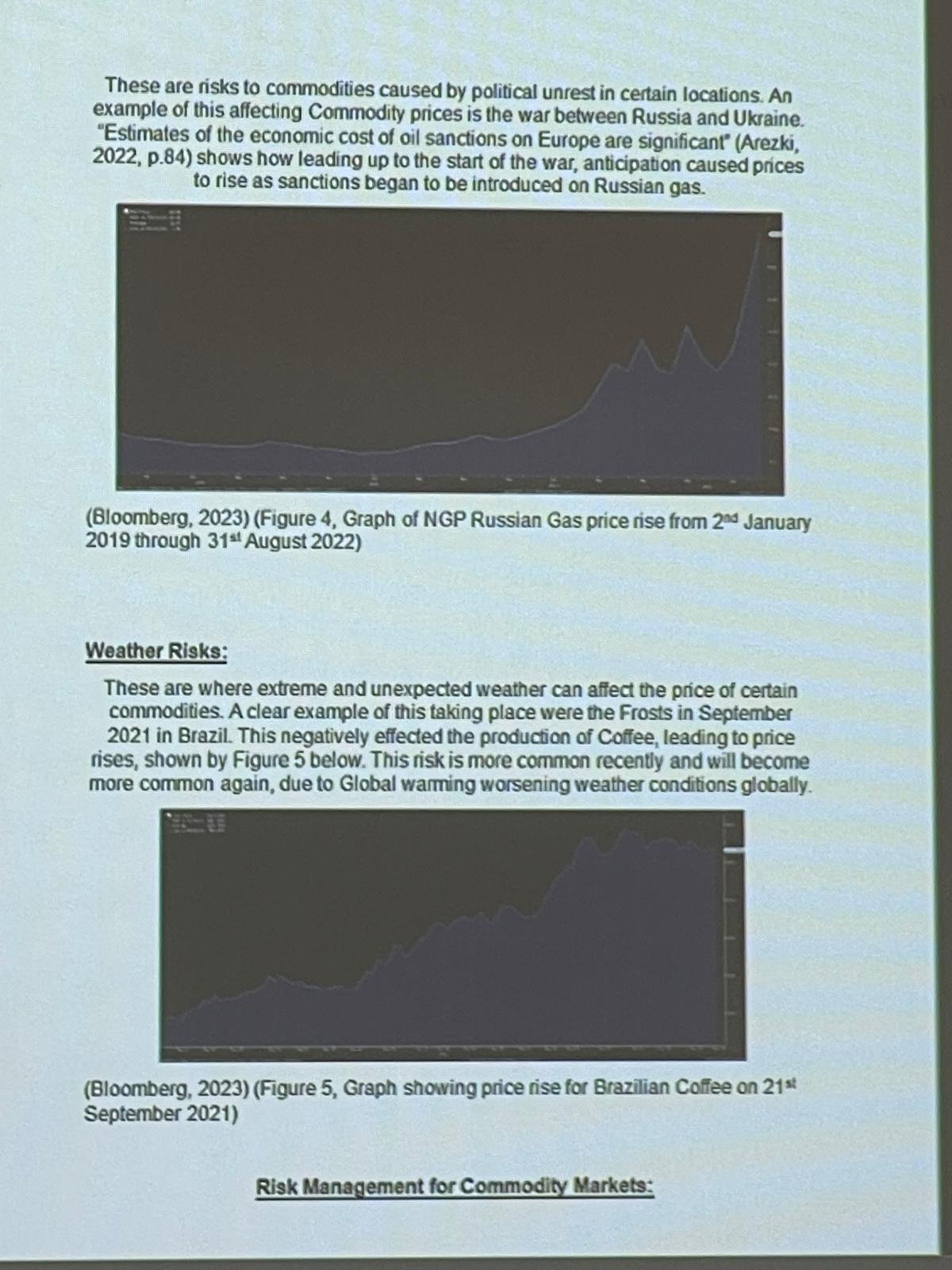
Political Risks
- Impact of Political Unrest:
- Political tensions and conflicts, such as the war between Russia and Ukraine, can significantly affect commodity prices.
- The anticipation and imposition of sanctions, especially on Russian gas, led to rising prices.
- Economic Cost of Sanctions:
- Sanctions have a substantial economic impact on regions involved, exemplified by the effect on Europe due to oil sanctions on Russia.
Graph Analysis
- NGP Russian Gas Price Rise:
- Time Frame: 2nd January 2019 - 31st August 2022
- Observation: A noticeable increase in prices leading up to and during the sanctions period.
Weather Risks
- Extreme Weather Effects:
- Unexpected weather events like frosts in Brazil can disrupt commodity production.
- Such events negatively affected coffee production, causing price spikes.
- Global Warming Influence:
- Global warming may exacerbate adverse weather events, leading to more frequent and severe impacts on commodity markets.
Graph Analysis
- Brazilian Coffee Price Rise:
- Observation Date: 21st September 2021
- Insight: The graph reflects a significant price increase due to adverse weather conditions affecting coffee production.
Risk Management for Commodity Markets
- Effectively managing political and weather risks is crucial for stability in commodity markets.
- Strategies may include diversifying supply sources, investing in predictive analytics for weather patterns, and implementing robust geopolitical risk assessments.
Extended readings: